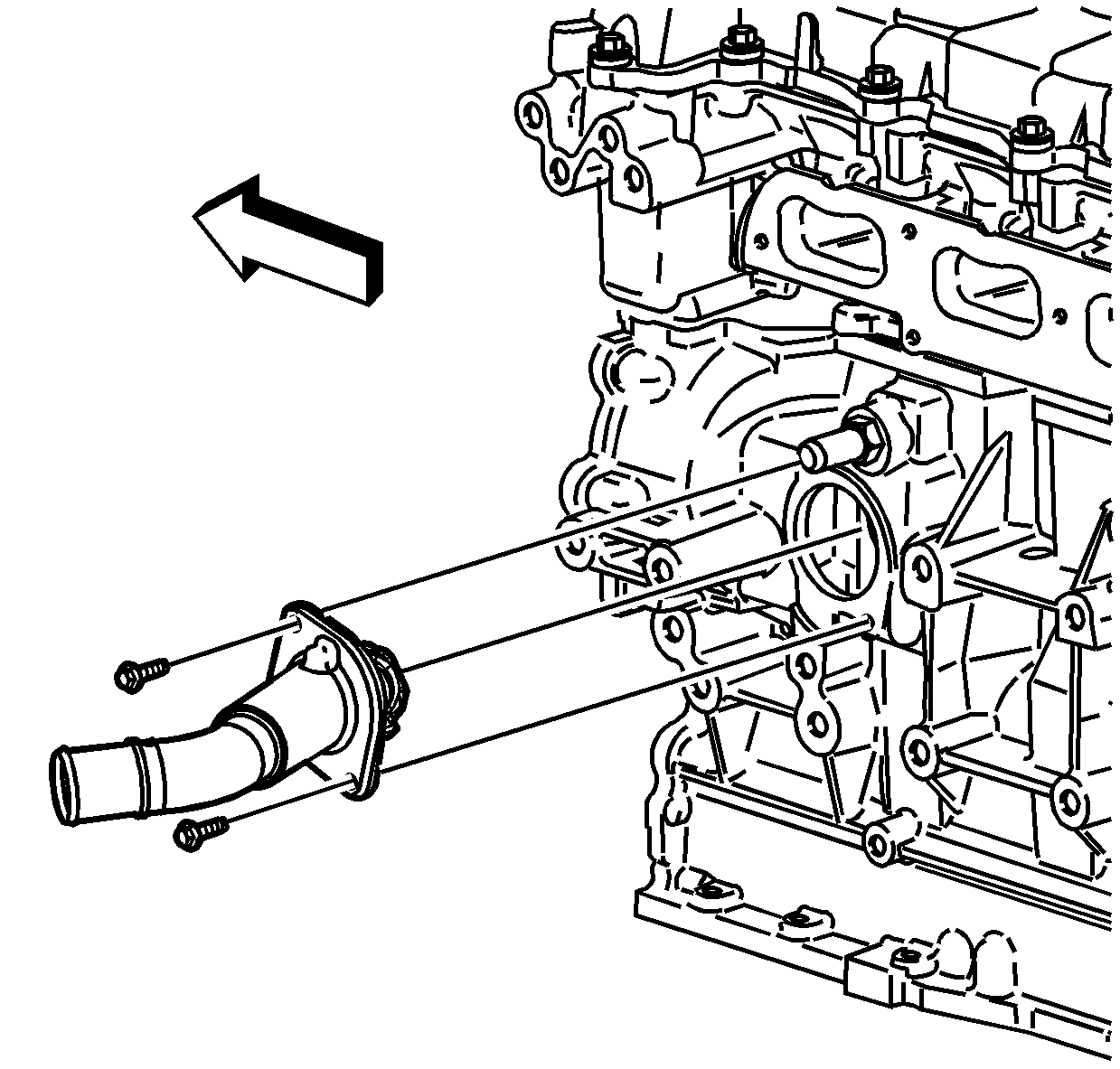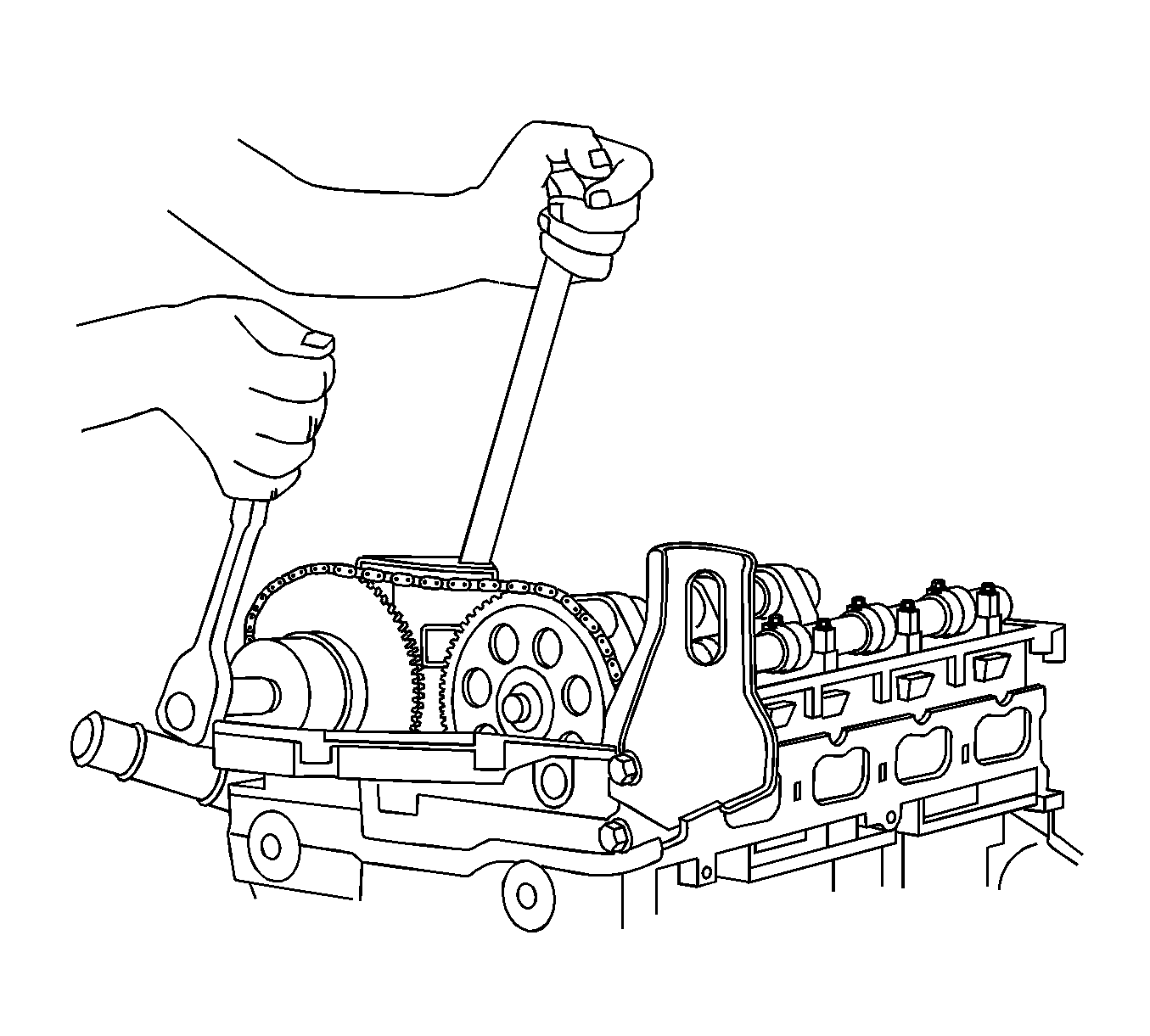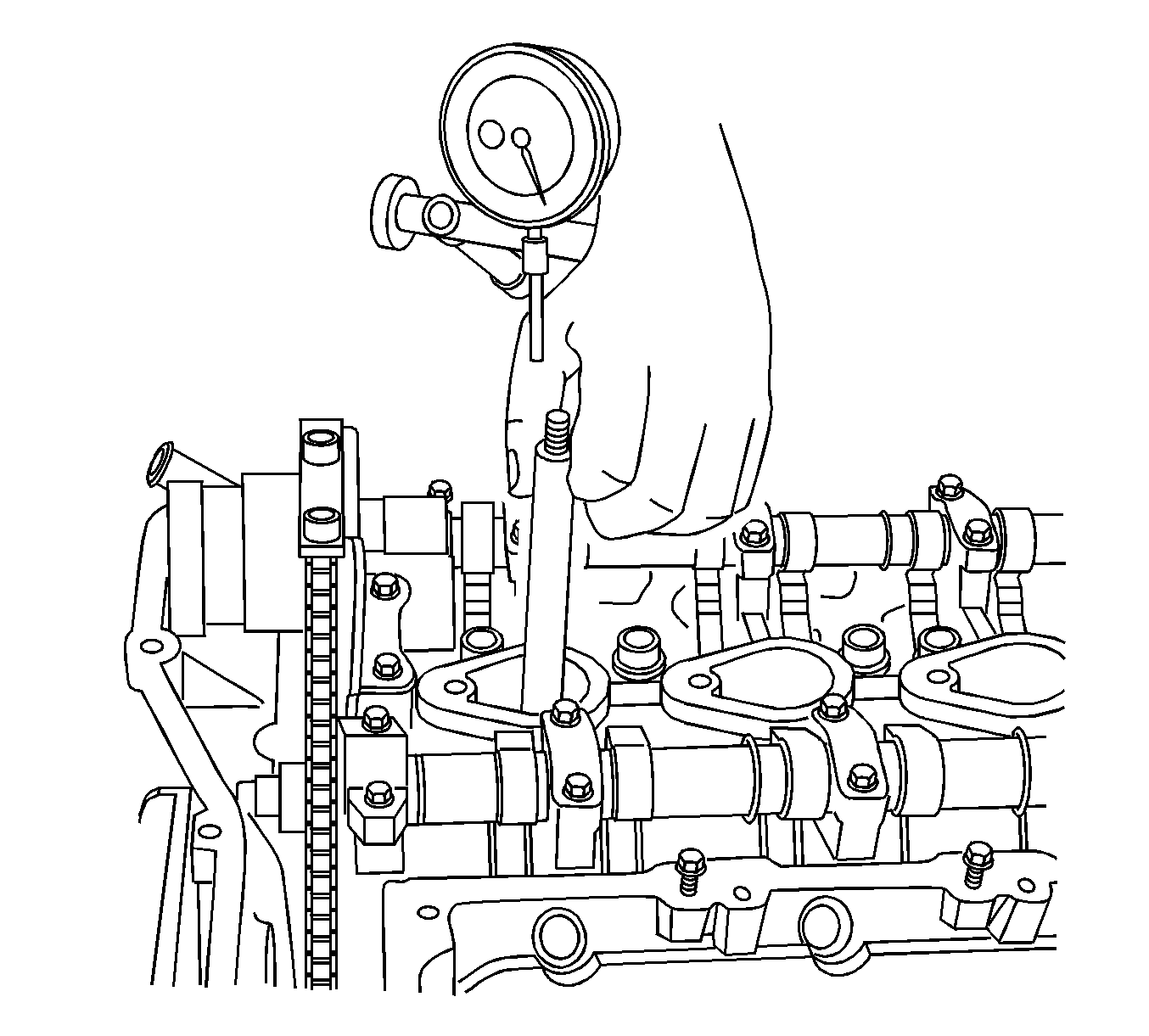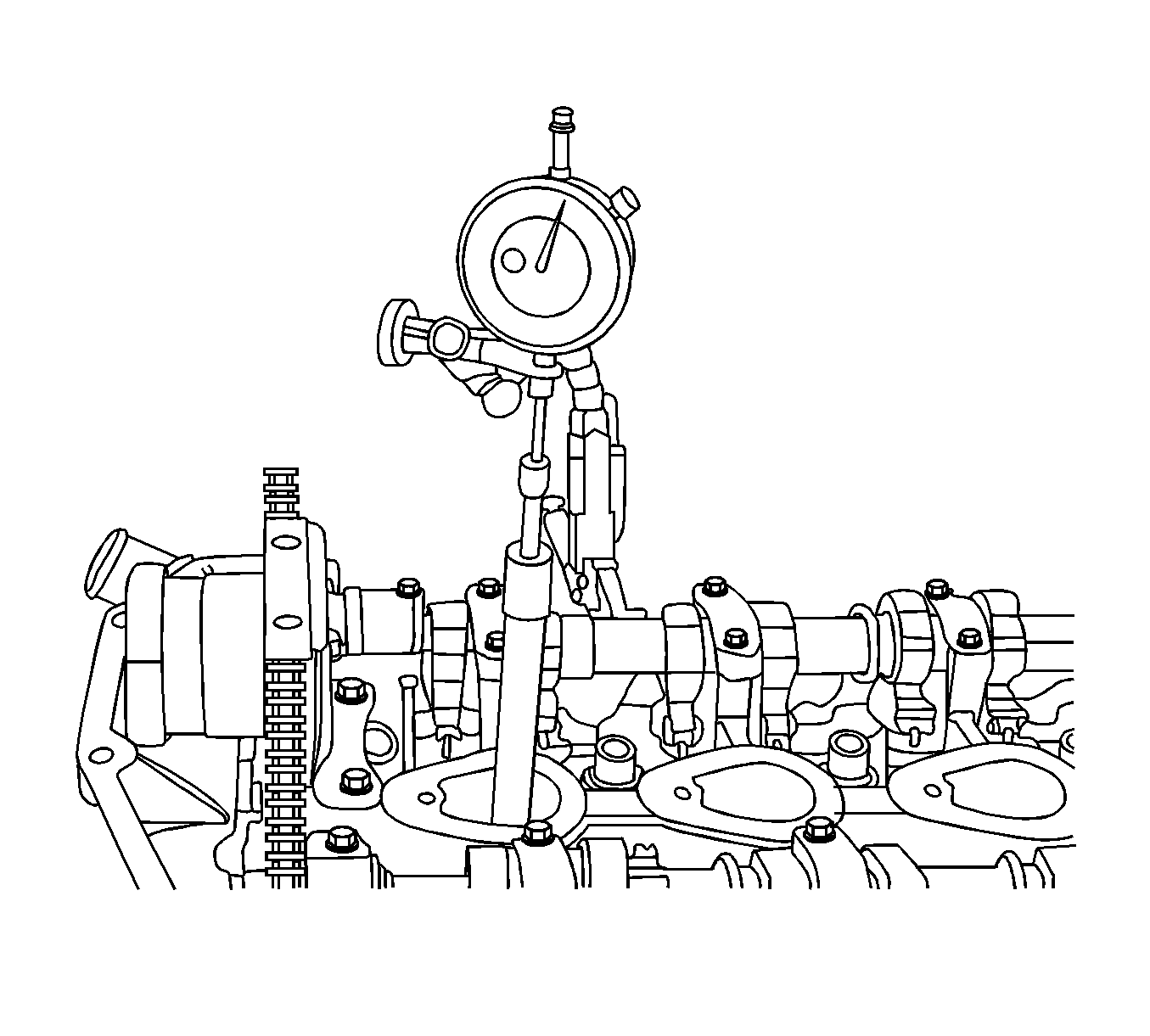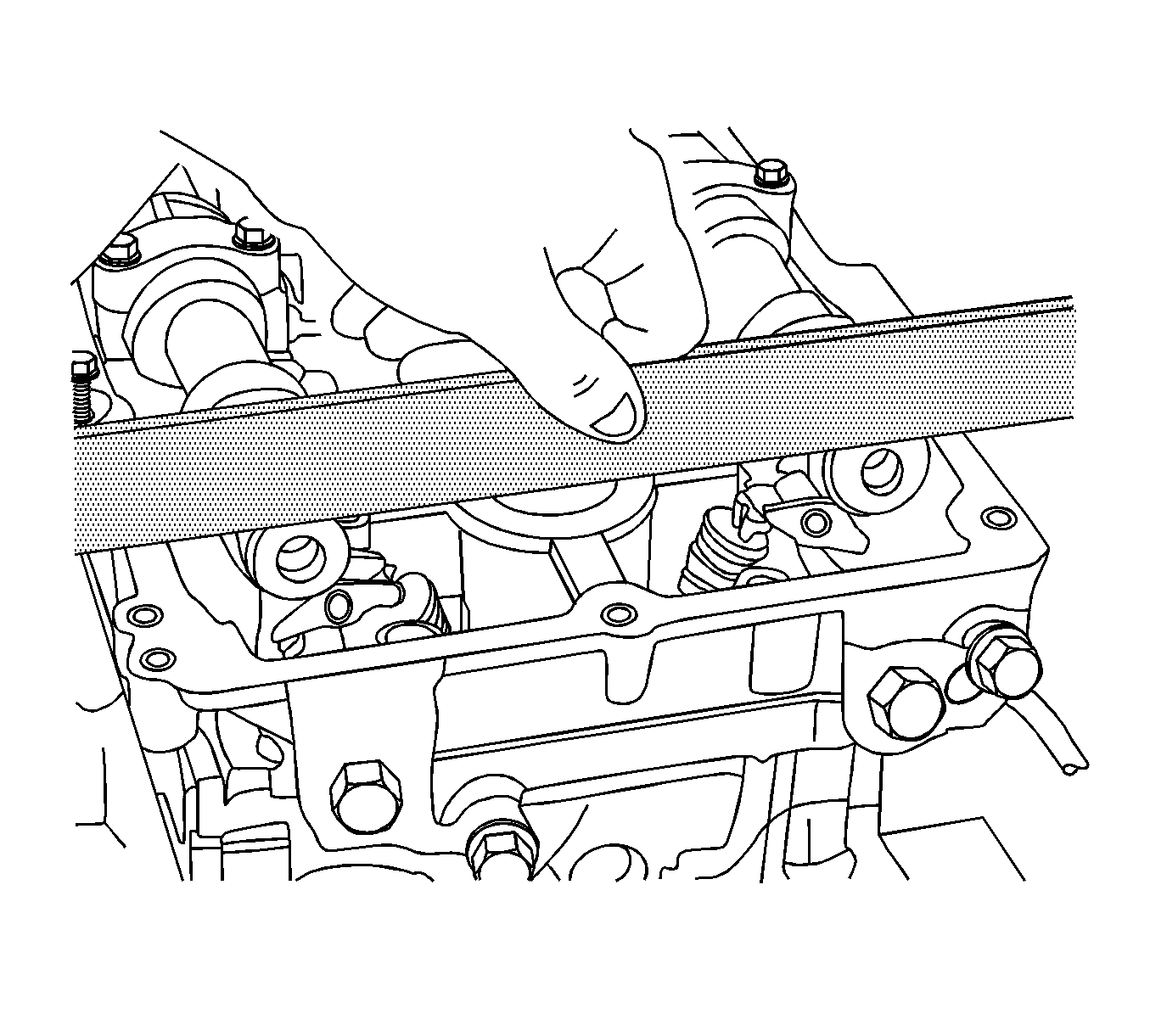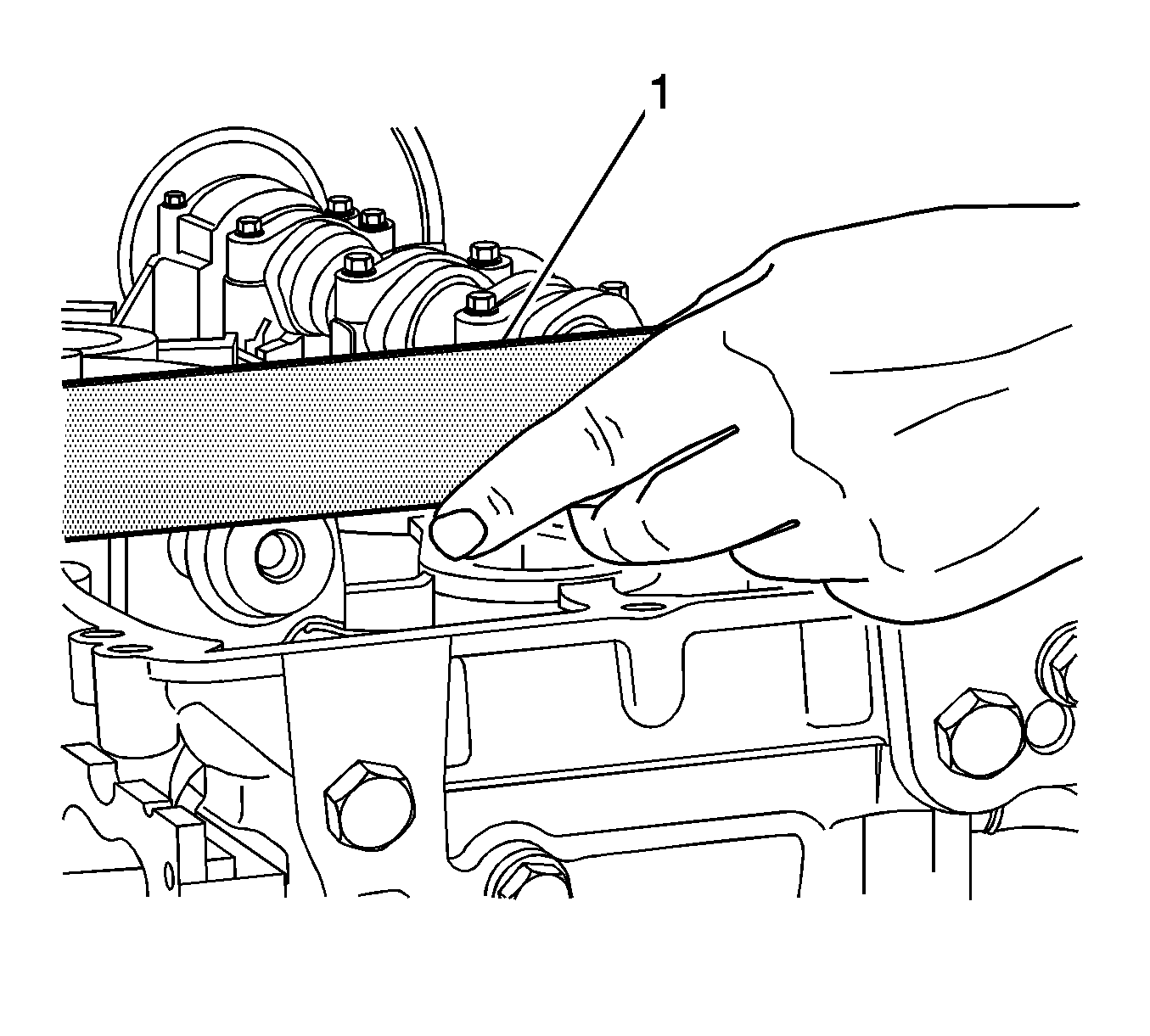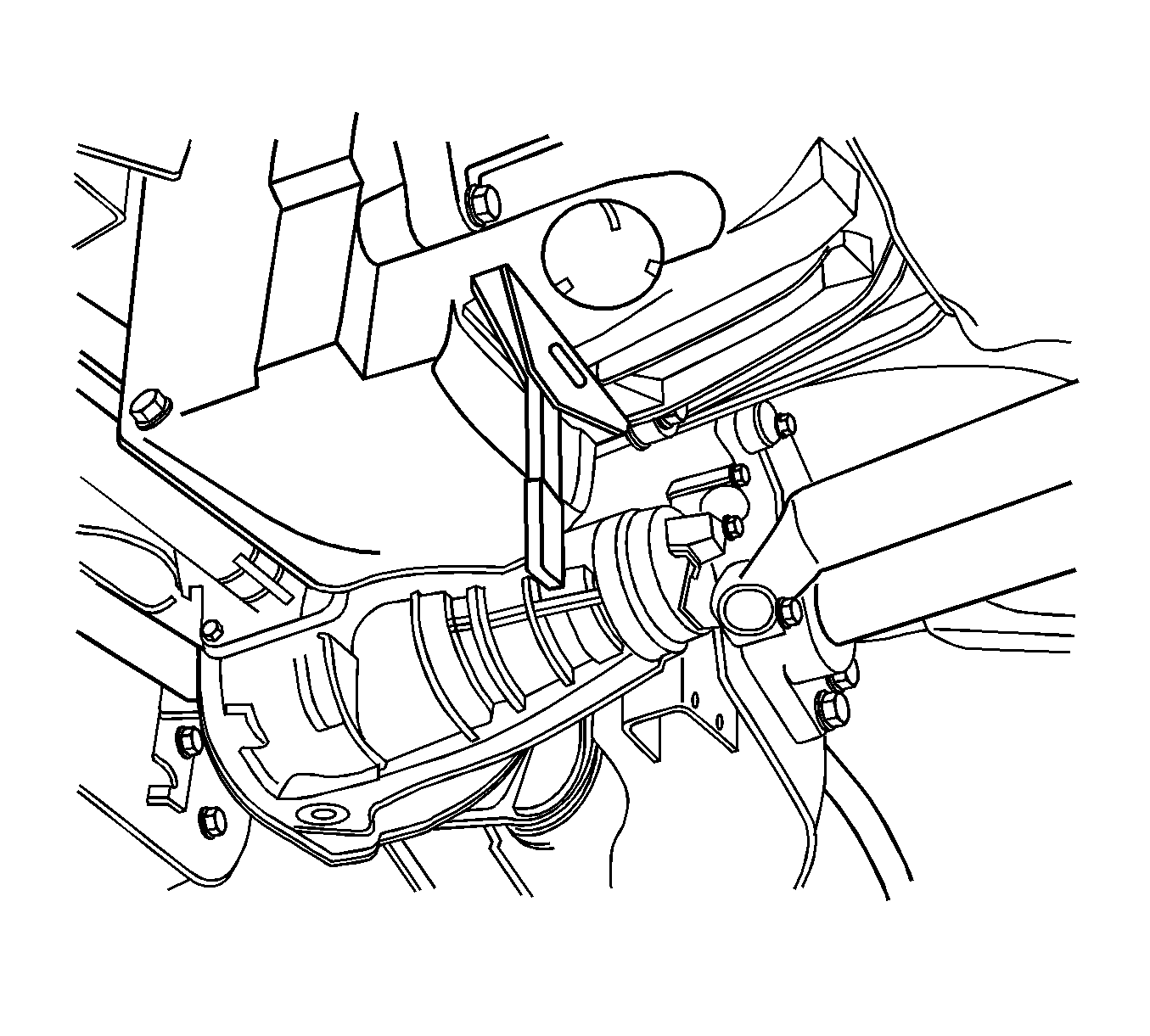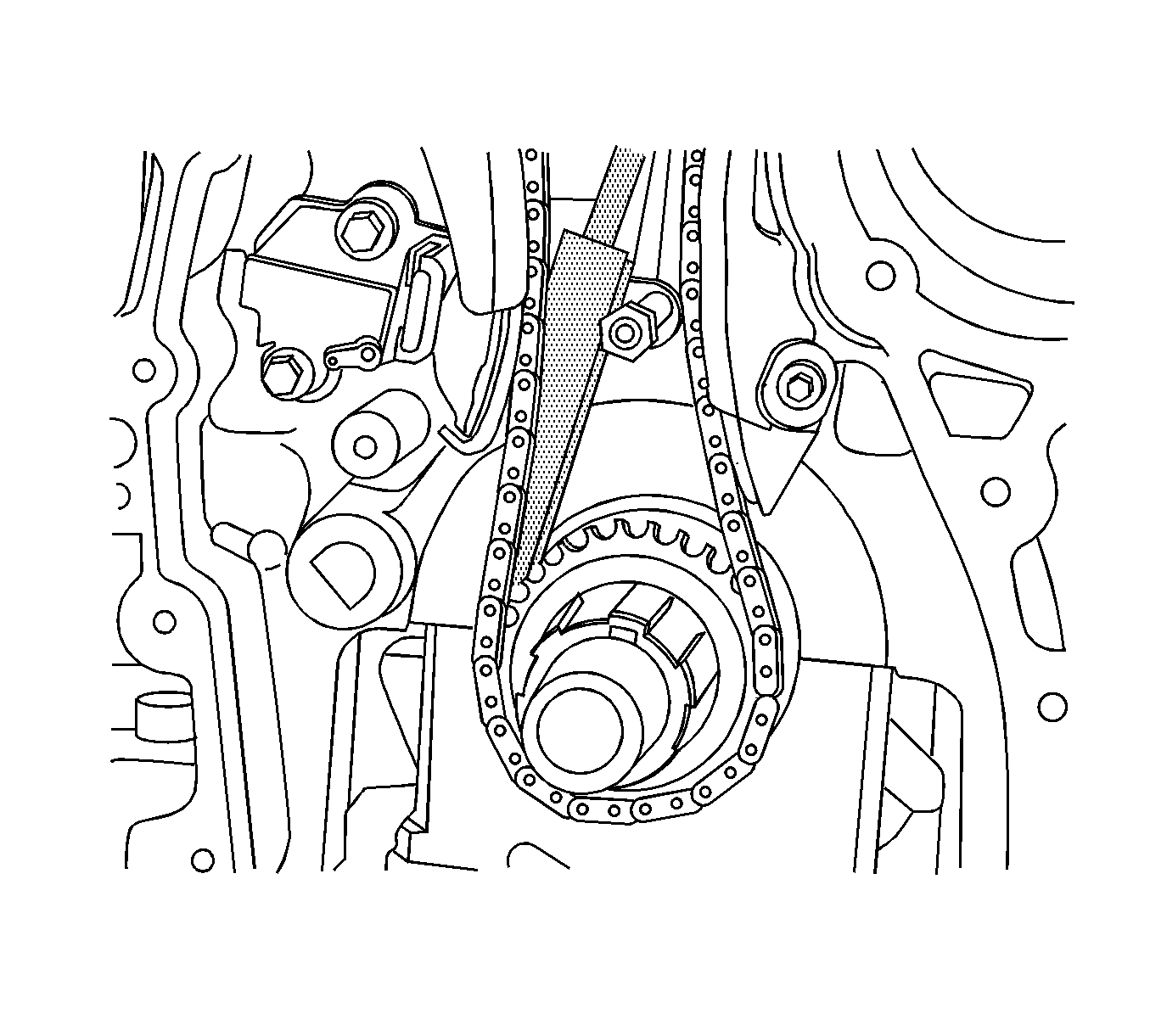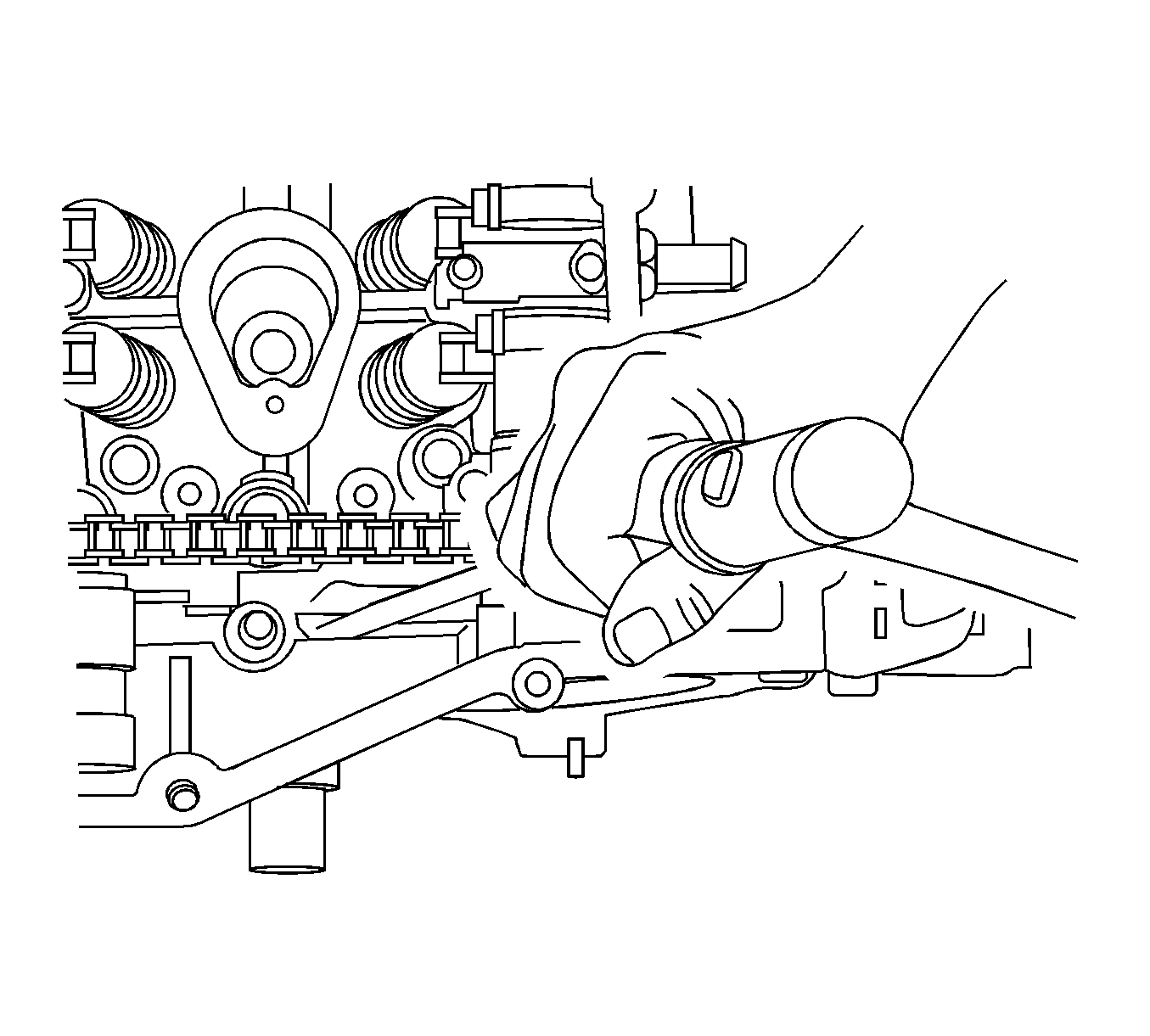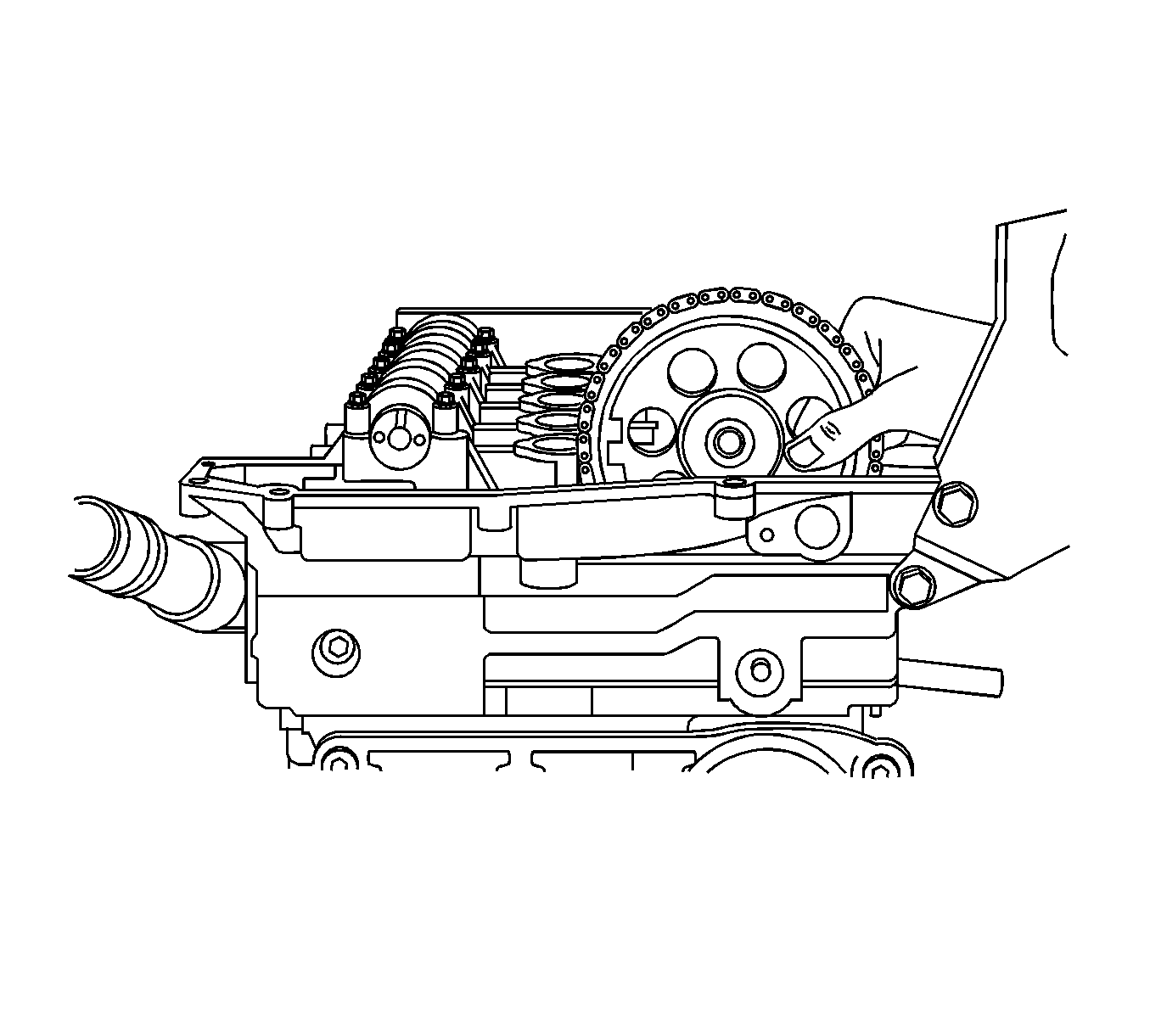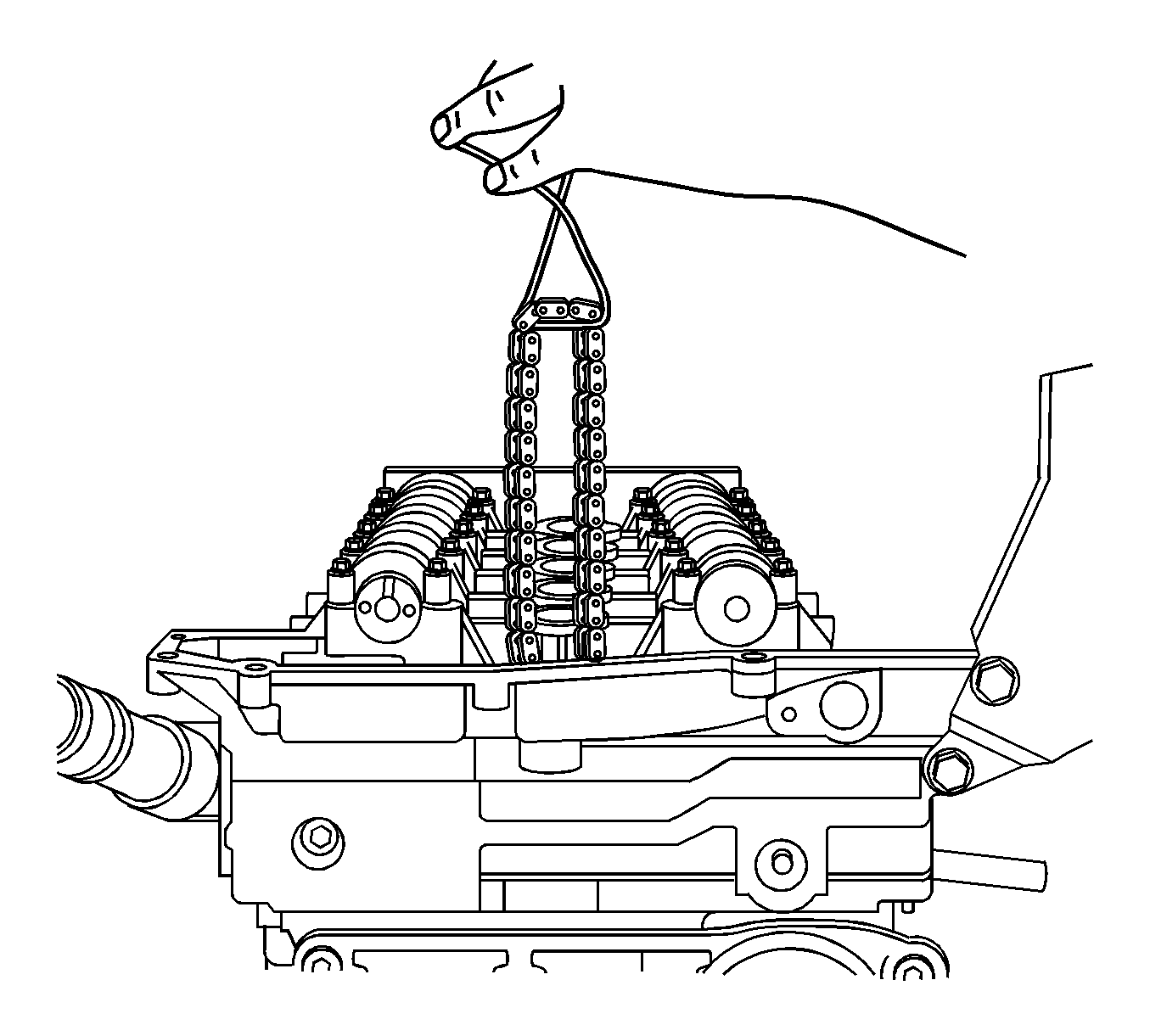- Assemble the cylinder head if necessary. Refer to
Cylinder Head Assemble
.

- Install the dowel pins, cylinder head locator, if necessary.
- Position a NEW cylinder head gasket to the engine block.
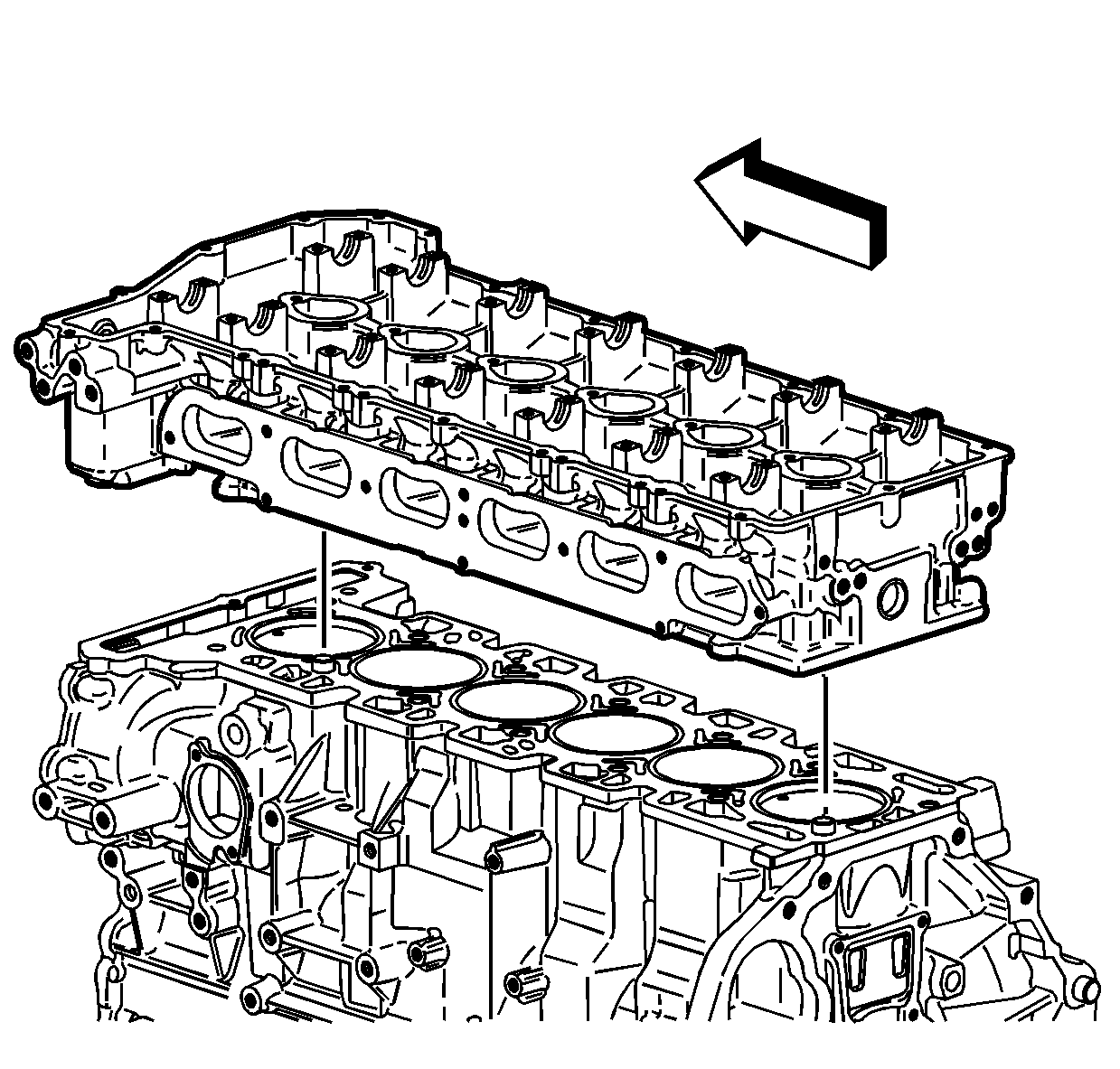
Important: Ensure all wires, components, etc. are out of the way when installing the cylinder head.
- Install the cylinder head.
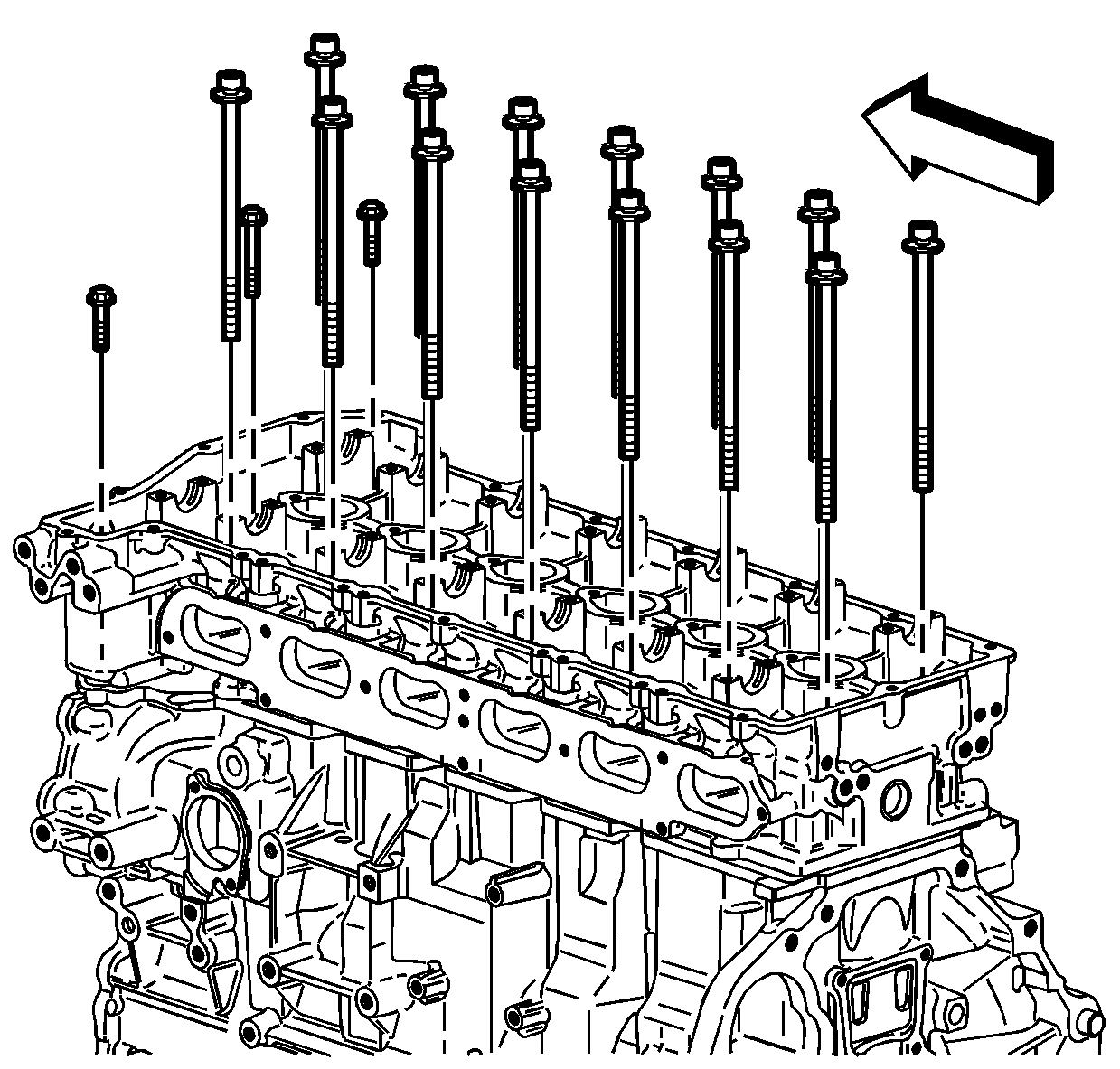
Notice: This component uses torque-to-yield bolts. When servicing this component
do not reuse the bolts, New torque-to-yield bolts must be installed. Reusing
used torque-to-yield bolts will not provide proper bolt torque
and clamp load. Failure to install NEW torque-to-yield bolts may lead to engine
damage.
- Install NEW cylinder head bolts.
Notice: Refer to Fastener Notice in the Preface section.
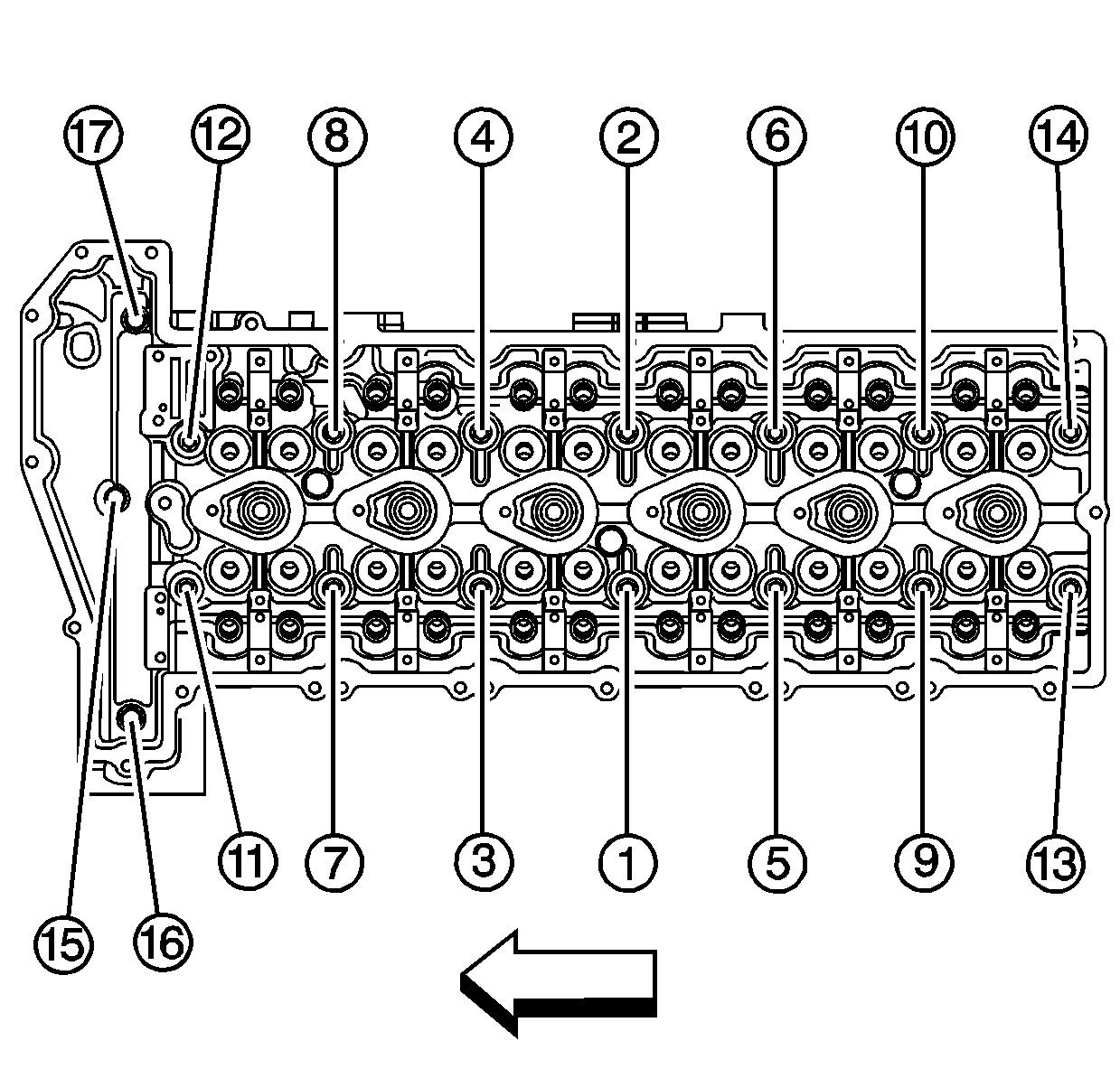
- Tighten the NEW cylinder head bolts in the following sequence:
Tighten
- Tighten the cylinder head bolts (1-14) in sequence to 30 N·m (22 lb ft).
Use the
J 45059
to rotate the cylinder head bolts (1-14)
in sequence an additional 155 degrees.
- Tighten the 2 short end bolts to 7 N·m (62 lb in).
Use the
J 45059
to rotate the short cylinder head end bolts an additional 60 degrees.
- Tighten the 1 long end bolt to 7 N·m (62 lb in).
Use the
J 45059
to rotate the long cylinder head end bolt an additional 120 degrees.

Caution: The camshaft holding tools must be installed on the camshafts to prevent camshaft rotation. When performing service to the valve train and/or timing components, valve spring pressure can cause
the camshafts to rotate unexpectedly and can cause personal injury.
Important: Before installing the camshafts, refer to
Camshafts Cleaning and Inspection
.
- Install the camshafts with the flats up using
J 44221
(1) . Refer to
Camshaft Installation
.
Notice: Tension must be always kept on the intake side of the timing chain to properly keep the engine in time. If the chain is loose the timing will be off, which may cause internal engine damage or set
DTC P0017.
Notice: The exhaust camshaft actuator must be fully advanced during installation. Engine damage may occur if the camshaft actuator is not fully advanced.
- Ensure that the camshaft position actuator is in the fully advanced position. Refer to
Camshaft Position Actuator Diagnosis
.
Important: To aid in aligning the actuator to the camshaft, use a 25 mm (1 in) open end wrench on the hex of the camshaft to rotate. This will ensure the alignment pin is properly engaged with the camshaft and hand
tighten the new exhaust camshaft sprocket bolt.
- Install the exhaust camshaft actuator/sprocket and chain onto the exhaust camshaft. Use the paint marks as an alignment guide.
Important: To aid in aligning the intake sprocket to the camshaft, use a 25 mm (1 in) open end wrench on the hex of the camshaft to rotate. This will ensure the alignment pin is properly engaged with the camshaft and
hand tighten the new intake camshaft sprocket bolt.
- Install the intake camshaft sprocket and chain onto the intake camshaft. Use paint marks as alignment guide.
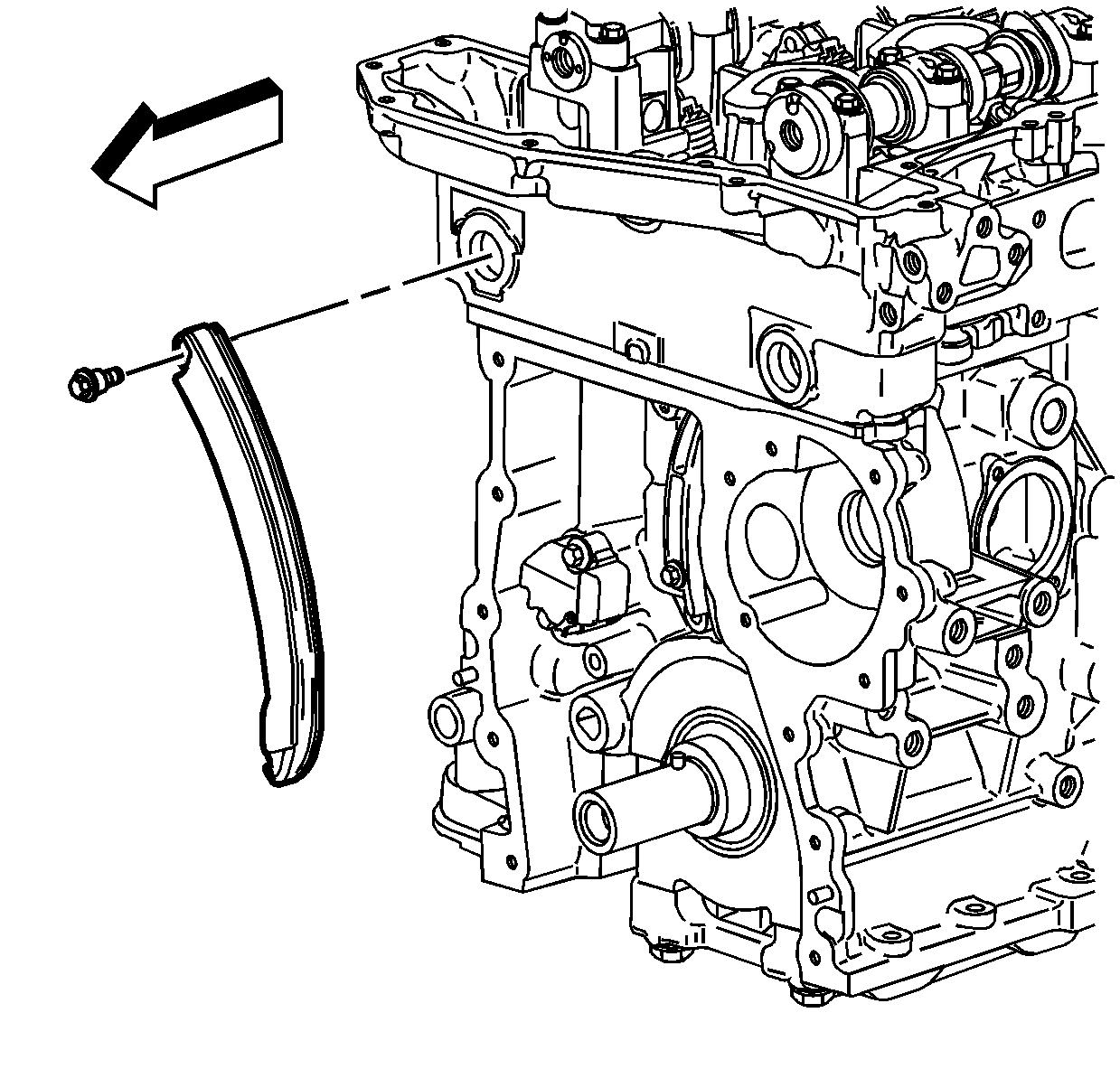
- Position the timing chain tensioner shoe to the engine.
- Install the timing chain tensioner shoe bolt.
Tighten
Tighten the timing chain tensioner shoe bolt to 25 N·m (18 lb ft).
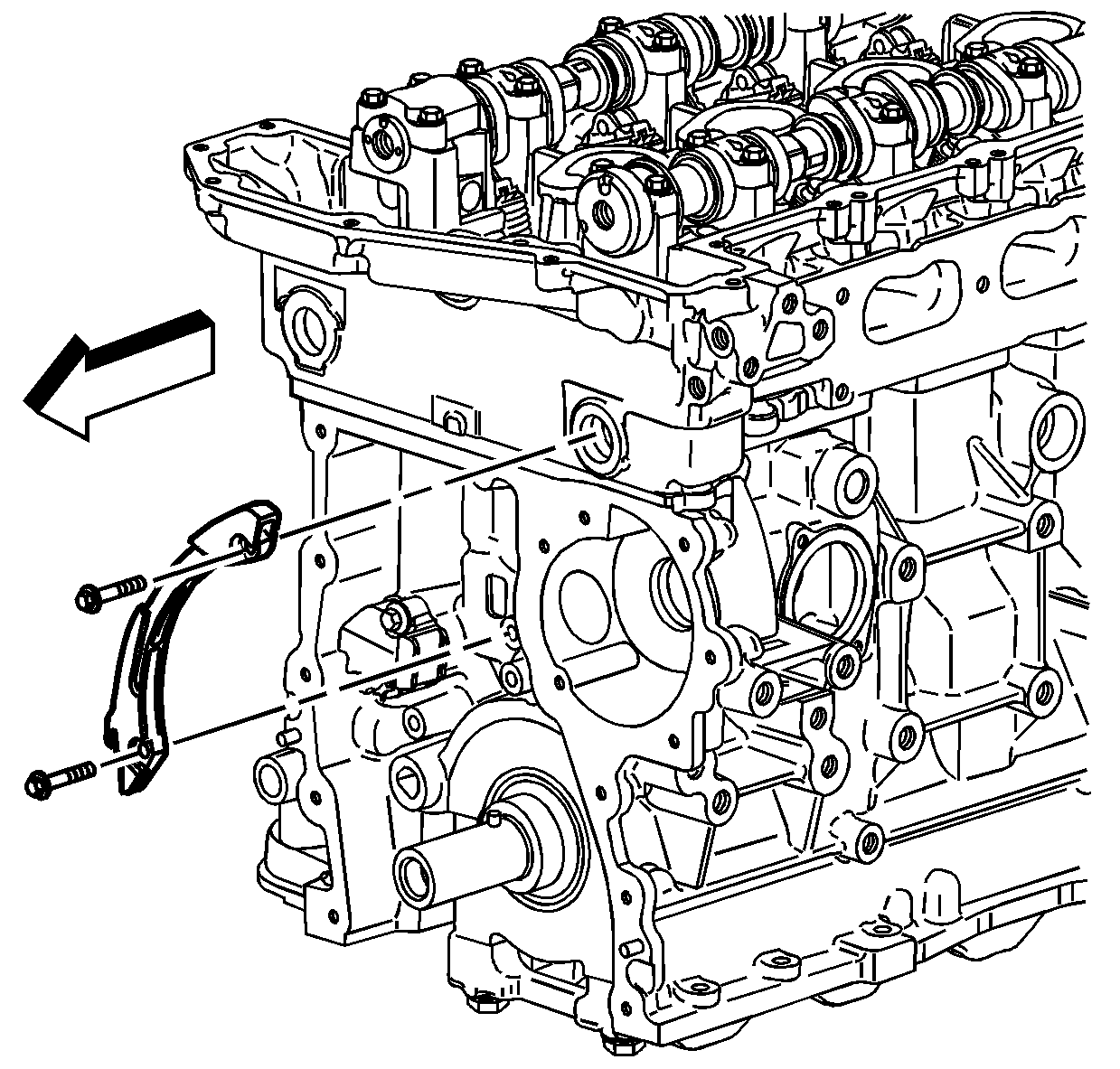
- Position the lower timing chain guide to the engine.
- Install the lower timing chain guide bolts.
Tighten
Tighten the lower timing chain guide bolts to 12 N·m (107 lb in).
- Install both upper timing chain tensioner shoe bolts.
Tighten
Tighten the tensioner shoe bolts to 25 N·m (18 lb ft).
- Install both upper cylinder head access hole plugs to the front of the cylinder head.
Tighten
Tighten the plugs to 5 N·m (44 lb in).

- Tighten the new intake camshaft sprocket bolt.
Tighten
Using
J 45059
, tighten the intake camshaft sprocket bolt to 20 N·m (15 lb ft) plus 100 degrees.
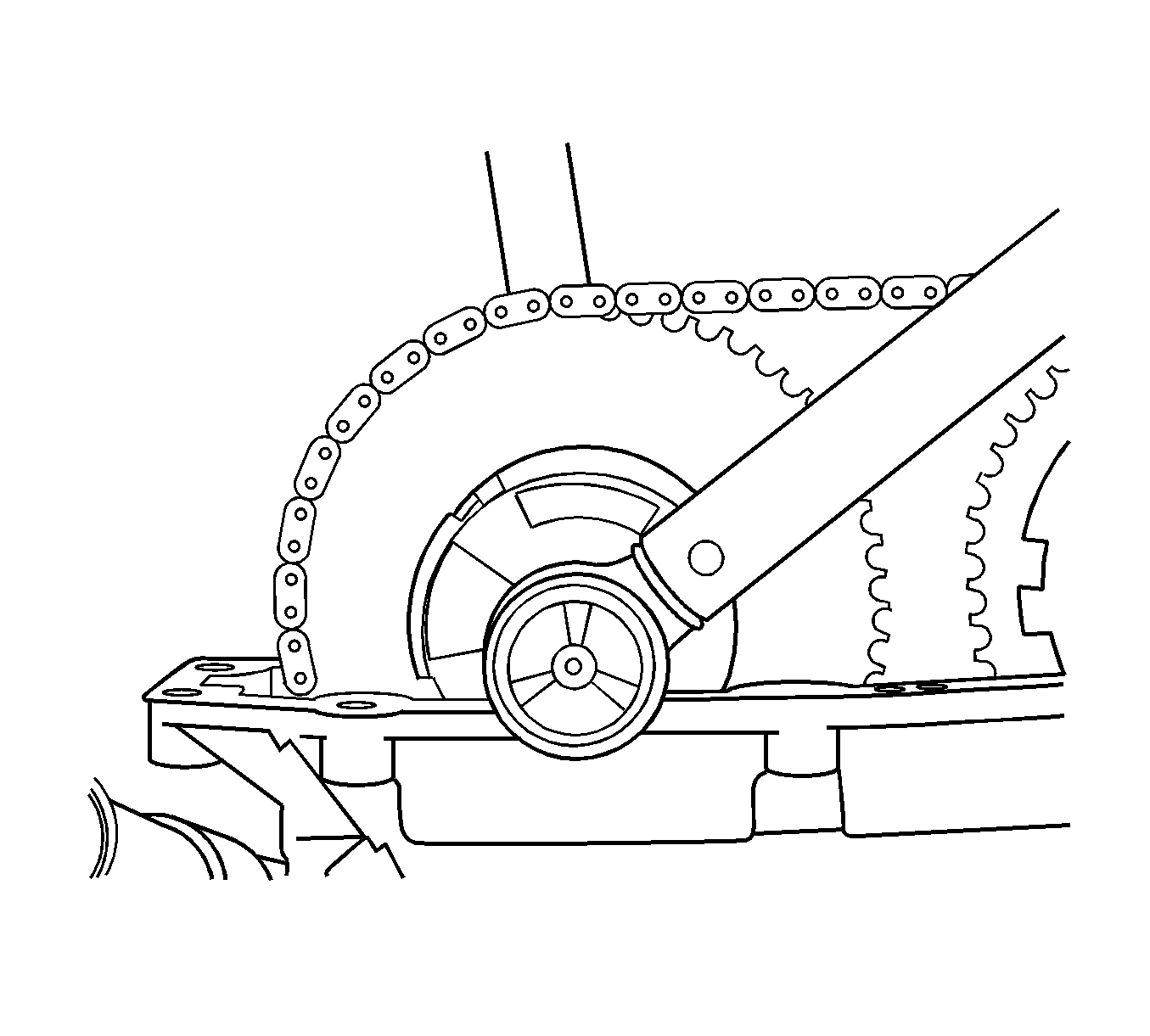
- Tighten the new exhaust camshaft actuator sprocket bolt.
Tighten
Using
J 45059
, tighten the exhaust camshaft actuator sprocket bolt to 25 N·m (18 lb ft) plus 135 degrees.

- Lift the vehicle and remove the
J 44226
.
- Lower the vehicle.
- Remove the
J 44221
from the back of the camshafts.
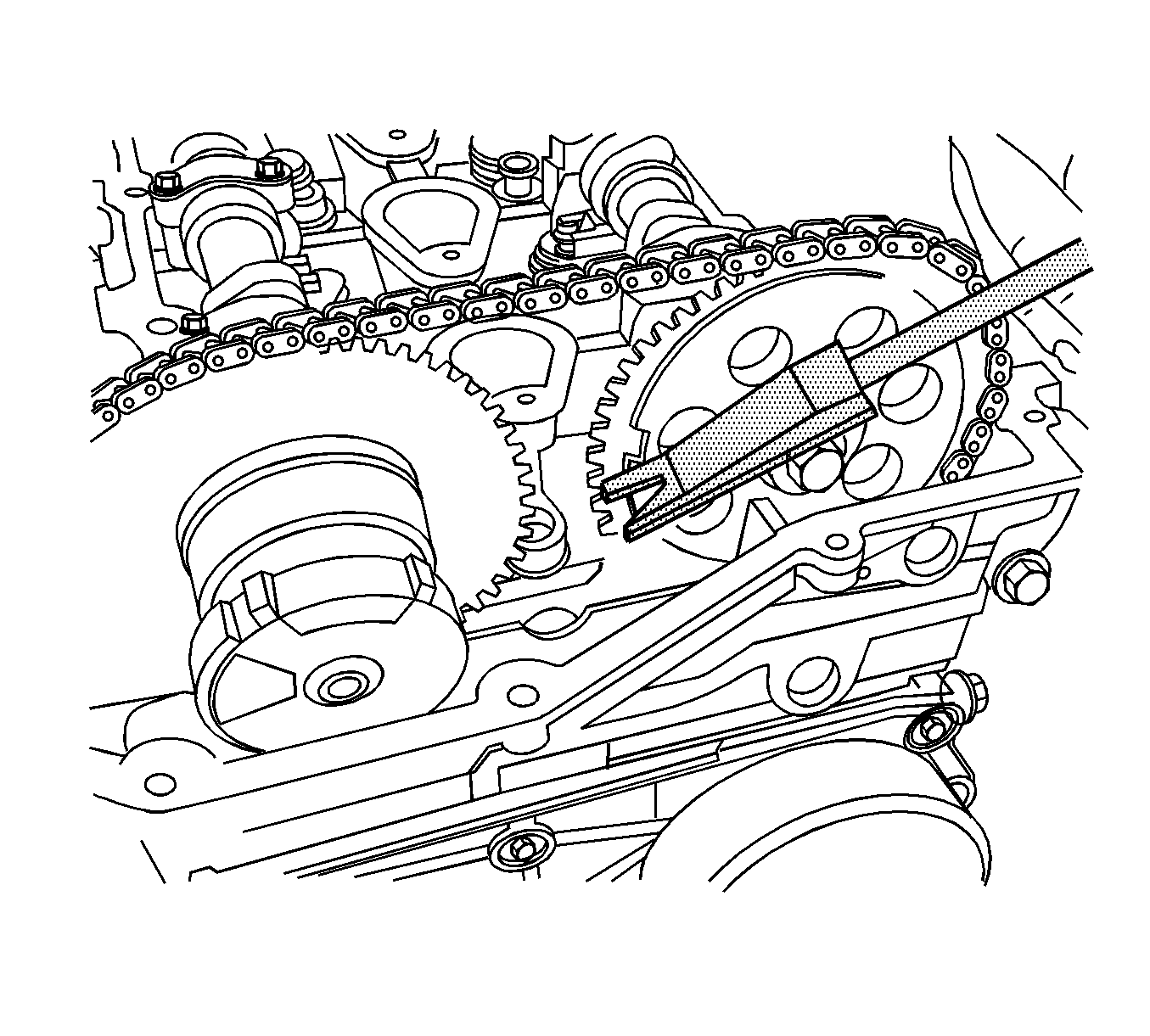
Notice: Ensure that the wedge tool is removed from engine prior to rotation. If the wedge tool is not removed, engine damage will result.
- Install the handle of
EN-48464
and remove the wedge portion of the tool from the engine.
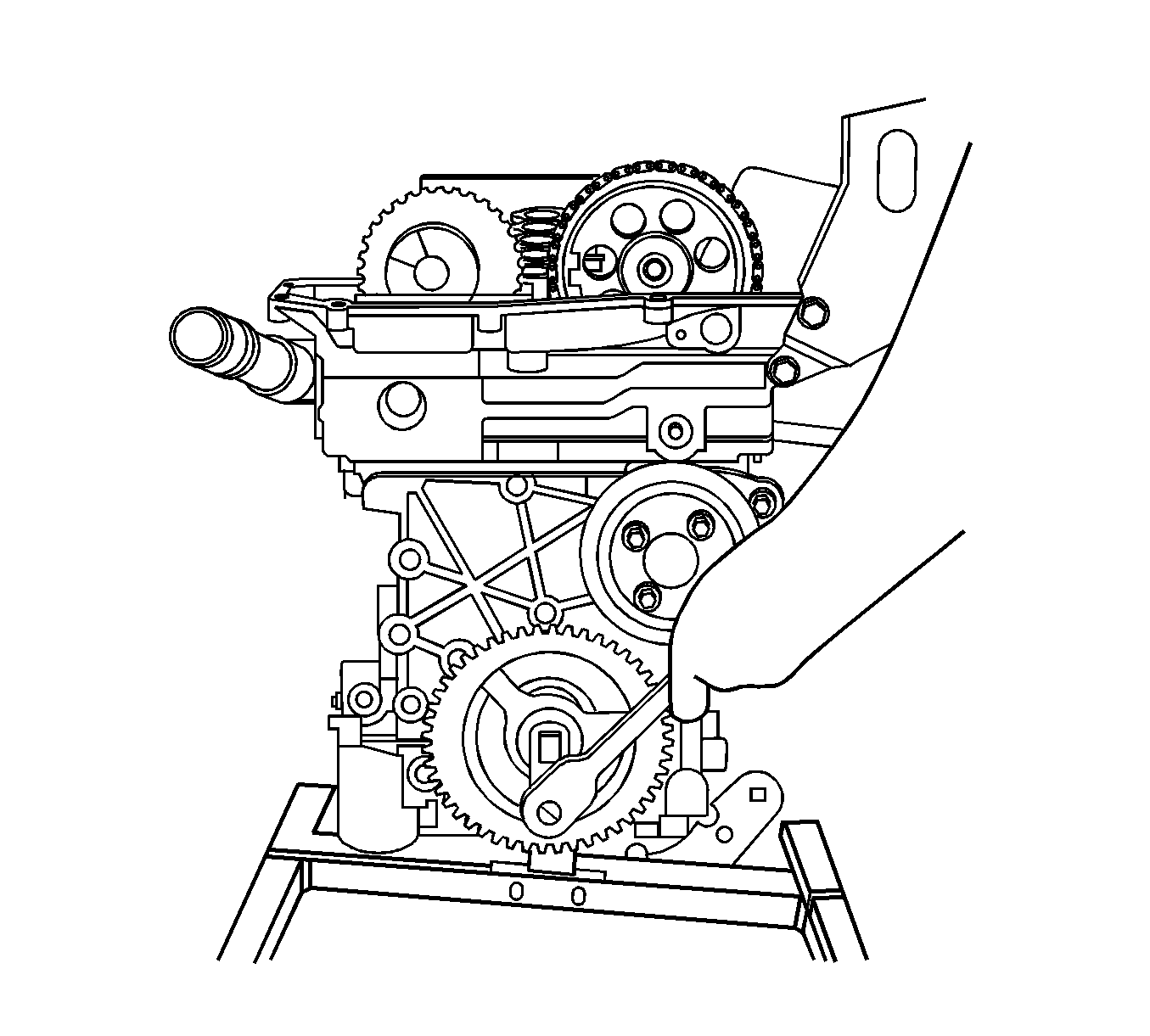
Important: It is critical that the engine is at TDC and not a couple of degrees off. If in doubt, repeat this step.
- Rotate the engine clockwise by hand two complete revolutions to TDC number 1 on the compression stroke. Refer to First Method or Second Method for TDC. If you go past TDC, rotate the engine back approximately 45 degrees before TDC and then
rotate clockwise up to TDC to ensure that the timing chain is tight (no slack) between the crank sprocket and the timing gears.

Important: DO NOT use the
J 44221
(1) , installed to the back of the camshafts, as a method to verify timing.
- Both intake and exhaust camshaft flats should be facing up and flat and level with the cylinder head. If
J 44221
is used to verify cam timing, you could be off approximately one tooth and cause DTC P0017
to set. If a worn or new
J 44221
is used to verify timing, the timing will be off.

- To verify timing, set a straight edge across the flats of the camshafts.

- A 0.005 inch feeler gage should not be able to slip under the straight edge (1). If the feeler
gage slips under one or both camshaft flats, then the timing is off. Repeat step 20 and recheck. If the camshaft flats are still not flat, the camshaft timing will have to be reset. This may require removal and reinstallation of one or both camshaft sprockets.
- Install the 1 long and 2 short cylinder head bolts next to the exhaust and intake timing chain tensioner shoes and tighten the bolts.
- Position the upper timing chain guide to the cylinder head. Apply threadlocker GM P/N 89021297 (Canadian P/N 10953488) to the upper timing chain guide bolt threads.
- Install the upper timing chain guide bolts.
Tighten
Tighten the bolts to 10 N·m (89 lb in).
- Install the radiator inlet hose and clamp to the cylinder head. Refer to
Radiator Inlet Hose Replacement
.
- Clean and inspect the camshaft cover. Refer to
Camshaft Cover Cleaning and Inspection
.
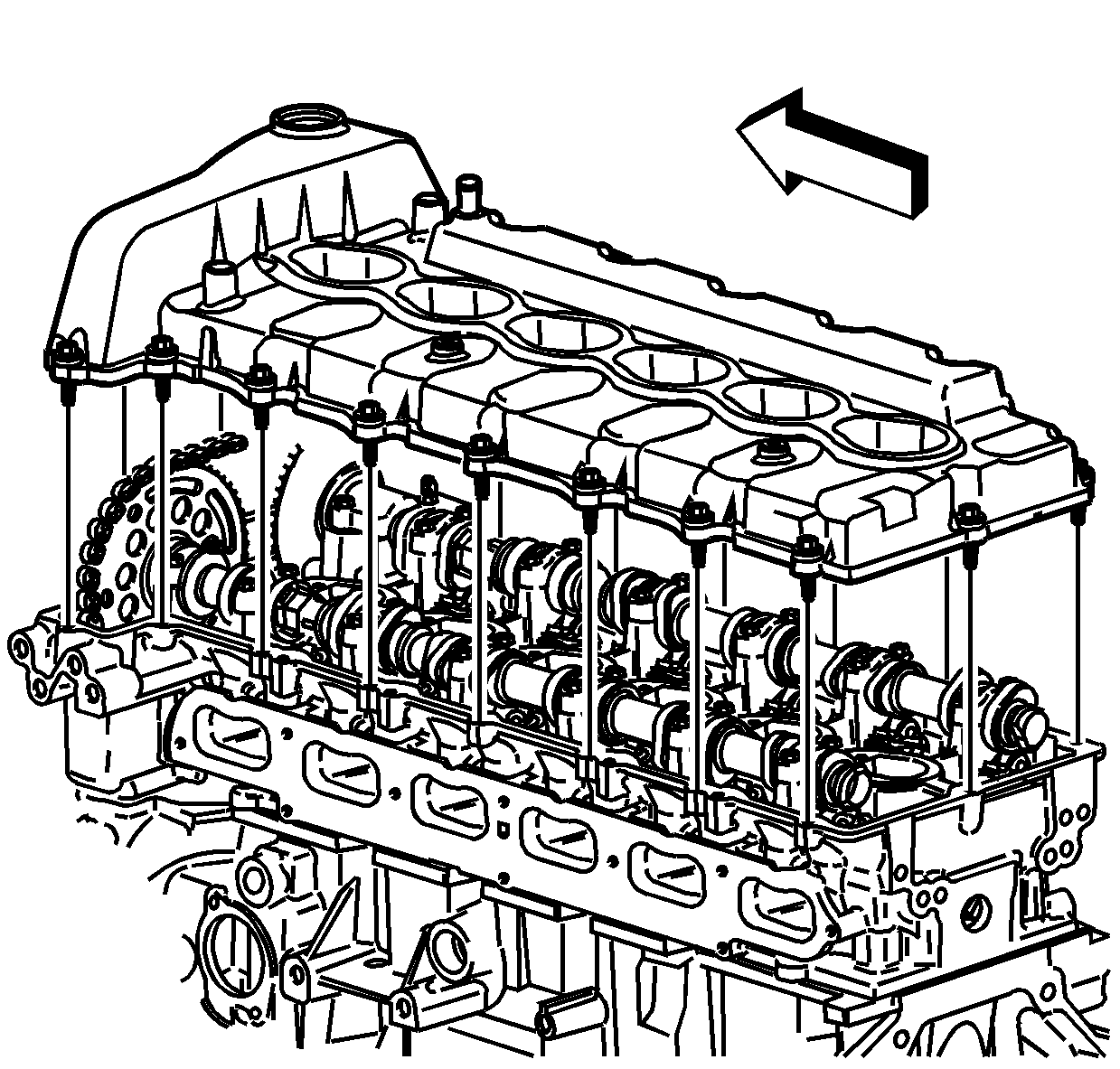
- Install a NEW camshaft cover seal and NEW ignition control module seals to the cam cover. Position the camshaft
cover to the cylinder head.
- Install the camshaft cover bolts.
Tighten
Tighten the bolts to 10 N·m (89 lb in).
- Check the gap on all of the spark plugs. The gap should be 1.08 mm (0.042 in). Tighten all of the spark plugs.
Tighten
Tighten the spark plug to 18 N·m (13 lb ft).
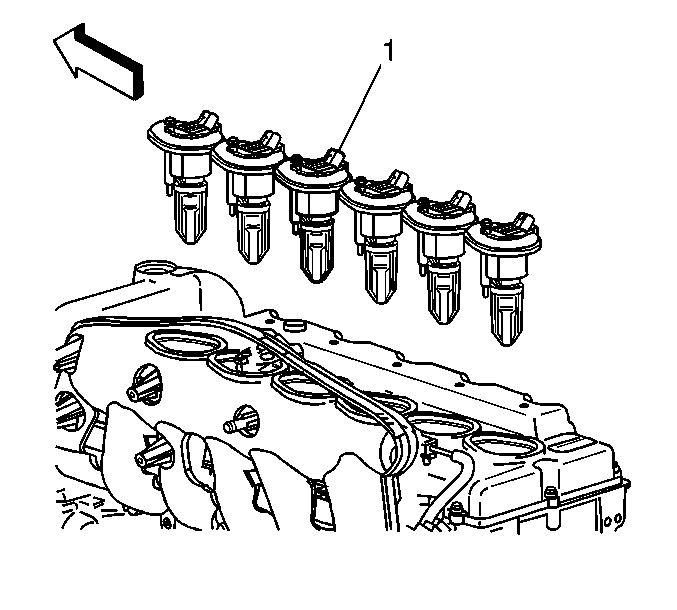
- Install the ignition coils (1) into the camshaft cover.
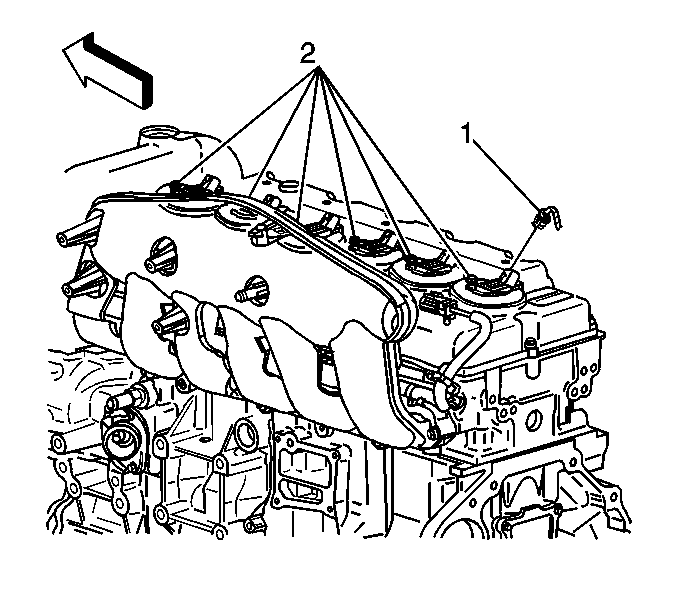
- Install the ignition coil bolts (2).
Tighten
Tighten the bolts to 10 N·m (89 lb in).
- Reposition the exhaust manifold to cylinder head and install the exhaust manifold bolts to the cylinder head. Refer to
Exhaust Manifold Replacement
.
- If equipped, install a NEW AIR injection gasket, then the cover and pipe studs to the cylinder head.
Tighten
Tighten the pipe studs to 25 N·m (18 lb ft).
- Install the exhaust manifold heat shield to the exhaust manifold.
- Apply anti-seize GM P/N 12371386 (Canadian P/N 89021945) to the exhaust manifold heat shield nuts.
- Install the exhaust manifold heat shield nuts.
Tighten
Tighten the nuts to 10 N·m (89 lb in).
- Install the intake manifold to the cylinder head. Refer to
Intake Manifold Replacement
.
Four-wheel drive--Raise the vehicle and install the blind intake manifold bolts from the left front
wheelhouse access.
Two-wheel drive--The bolts are accessible from the top of the engine.
- Reposition the engine wiring harness bracket to the engine and harnesses. Install the engine wiring harness bracket bolts.
Tighten
Tighten the bracket bolts to 10 N·m (89 lb in).
- Install the left front wheelhouse panel and the left wheel and tire. Refer to
Wheelhouse Panel Replacement
.
- Drain the engine oil again.
- If removed, install the radiator outlet hose. Refer to
Radiator Outlet Hose Replacement
.
- Install the cross-vehicle wiring harness connectors to the following components:
| • | Harness clamps at power steering pump |
| • | Wiring harness fastener at right front inner fender |
| • | Exhaust camshaft actuator |
| • | AIR valve and connectors |
- Install the PCV pipes to the intake manifold. Refer to
Positive Crankcase Ventilation Hose/Pipe/Tube Replacement
.
- Reposition the Fuel/EVAP lines to the intake manifold retainer. Refer to
Evaporative Emission Hoses/Pipes Replacement - Engine/Chassis
.
- Install the following components:
- Install the air cleaner element and resonator. Refer to
Air Cleaner Element Replacement
and
Air Cleaner Outlet Resonator Replacement
.
- Install NEW engine oil. Refer to
Engine Mechanical Specifications
.
- Install NEW coolant. Refer to
Cooling System Draining and Filling
.
- Install a scan tool and start the engine.
